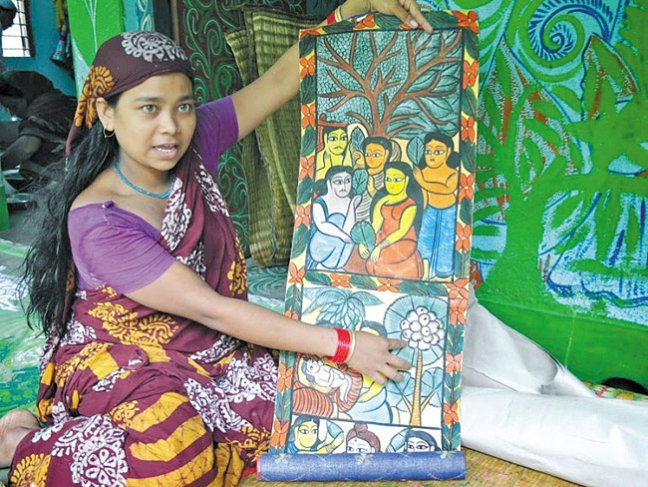Indian Folk Art
A group of performers shows up in the village square, unrolls a scroll covered every inch in vivid storyboard images, and based on those images, the performers entertain, sometimes all night, with song, dance or dramatic re-enactment. India’s vibrant folk art history, found in villages across the continent, involves intricately painted narrative images that traditionally are accompanied by performance art.
UH’s East-West Center Gallery invites visitors to delve into this world with “Colorful Stories: Indian Folk Paintings,” a display of paintings, scrolls and story boxes with folding panels, as well as videos that screen samples of these folk performances. While some of these localized art traditions date back hundreds of years, the 25 or so pieces on exhibit date from the 1960s to present.
mw-art-101514-indianfolkpaintings1
“All of the arts of India are completely interrelated — dance, sculpture, painting, music and theater are all interrelated,” says curator Michael Schuster. “There’s never one without a suggestion of the other. Most of the painting traditions come in some way from storytelling and performative traditions.”
As with many classical Indian dance forms, Schuster points out, the paintings begin with an offering to the Hindu elephant god Ganesh, who helps one to overcome obstacles. The painters make their offering by having the first image on the story-art be of Ganesh.
There’s no better person to curate the exhibit than Schuster, whose Ph.D. focused on Asian theater — and Indian public theater, in particular — meaning he’s spent an awful lot of time engaged in research in that blissful, colorful land that awakens the senses. Some of the pieces on display are from his own collection.
“The Patua people from West Bengal are interesting,” notes Schuster. “They’ll merge all aspects of whatever they need to in life to continue their art, and there’s permeability. They were perhaps originally tribal people of some sort, then Hindu, then Islamified, so they’ll do Hindu and Muslim stories, and tribal too. They’ll do scrolls of any sort, depending on who their audience will be.”
The government sometimes makes contemporary use of this age-old method of information dispersal by commissioning the Patua to focus on issues such as HIV awareness, human trafficking or contraception. Another contemporary aspect is that women now also engage in what was traditionally a male-dominated art form.
Other styles include the Kavad, Bhopa, Madhubani, Kalamkari and Pattachitra traditions, with each flaunting a distinct style, and often using natural dyes and pigments to tell their stories of gods and epic or local heroes. While the Bhopa storytellers of Rajasthan were lower caste and were invited to perform during times of misfortune, Madhubani paintings of the Bihar region were festive, with women applying paint to the floors and walls of village huts for weddings and other celebratory rituals. The tradition was modernized during a severe drought in the region in the ’60s. Via encouragement from the All India Handicrafts Board, the women began painting on paper or cloth so they could sell their work.
One time-intensive tradition is Kalamkari painting. These cloth paintings are used as scrolls, temple hangings or banners and depict scenes from the Hindu epics, the Ramayana or Mahabharata. One color of dye is applied, and then the cloth must be washed to affix the dye, with the process being repeated up to 20 times for the application of each additional color.
The gallery is accompanied by a series of talks and a film.
The Oct. 19 film retells a folk-tale from Rajasthan, followed by talks Nov. 9 and 16, Dec. 7, and Jan. 11, 2015, by experts from various UH departments in language, art, history, theater and dance.
“The talks will be quite enlightening,” says Schuster. “Nov. 9, Sai Bhatawadekar, a UH professor in Indo-Pacific languages, will be talking about generations of artists in her family. Her family has been painters for four generations and a lot of them have been very influenced — as are many Indian artists — by various folk traditions.
“Nov. 16, Paul Lavy, a professor in the Department of Art and Art History, will be talking about images of Krishna, which are vital in understanding these paintings because there are so many images of Krishna in the folk traditions.
“These folk traditions are so diverse, colorful and unique, and they’ve had great impact on contemporary Indian art.”
the TICKET stub
COLORFUL STORIES
When: During gallery hours Sunday-Friday
Where: East-West Center Gallery
More Info: 944-7177, arts.eastwestcenter.org






